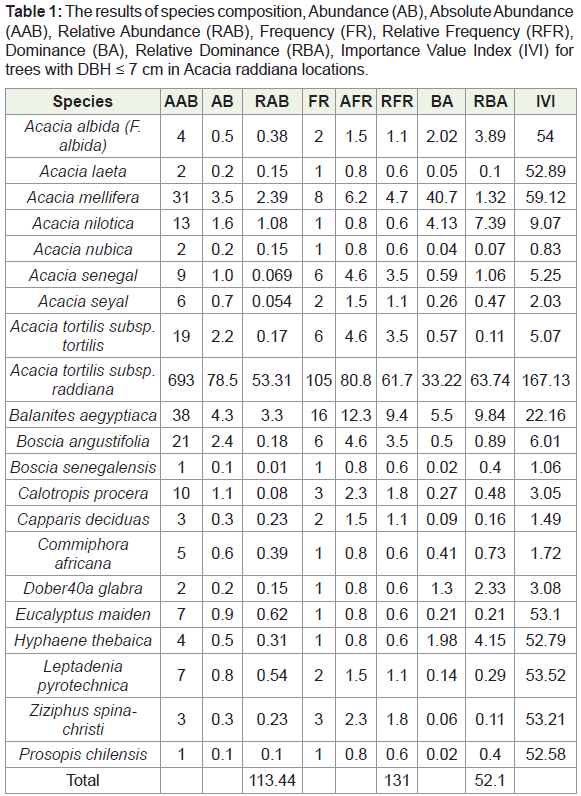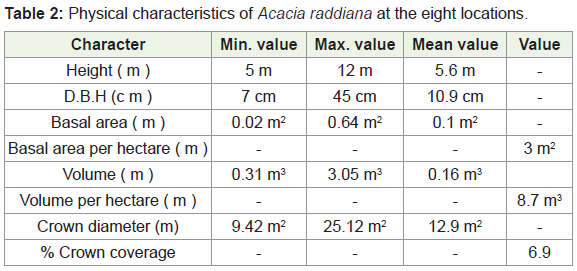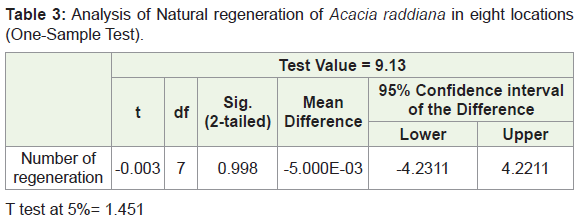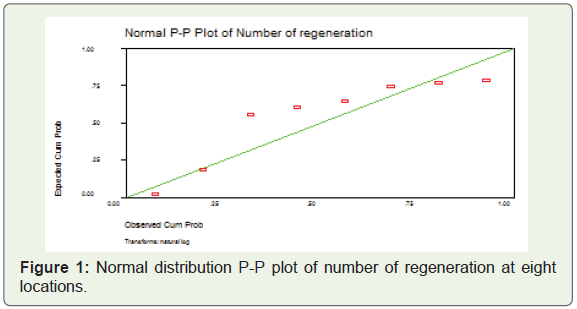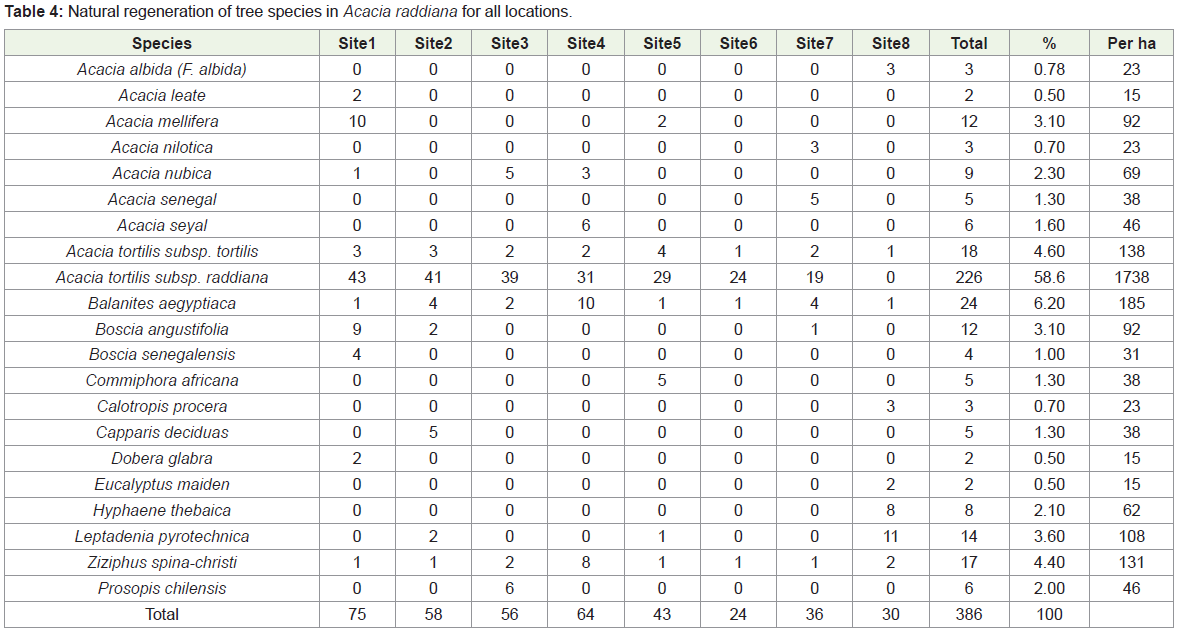Research Article
Some Aspects of Ecological Characteristic of Acacia tortilis subsp. raddiana
Goda MMB1, Dosougi MA2, Osman A3 and Ibrahim AM4*
1Forest National Corporation, Sudan
2Collage of Agricultural Studies, Division of Forests, Sudan University, Sudan
3University of Bakhtalruda, Sudan
4Livestock Marketing & Resilience Programme (LMRP), Sudan
Corresponding author: Ibrahim AM, Agricultural Socio-economist & Rural Development Specialist, Livestock Marketing & Resilience Programme (LMRP), Sudan, Tel no: +249 91 000 7070; E-mail: abedokosti2222@gmail.com
Citation: Goda MMB, Dosougi MA, Osman A, Ibrahim AM. Some Aspects of Ecological Characteristic of Acacia tortilis subsp. raddiana. J Environ Soc Sci. 2019;6(1): 138
Copyright ©2019 Goda MMB, et al. This is an open access article distributed under the Creative Commons Attribution License, which permits unrestricted use, distribution, and reproduction in any medium, provided the original work is properly cited.
Journal of Environmental and Social Sciences | Volume: 6, Issue: 1
Submission: 27/02/2019; Accepted: 16/04/2019; Published: 20/04/2019
Abstract
This study conducted during the season 2017 at Eldouim locality is in the northern White Nile State of the Sudan, where the main objective of the study was made that to address the occurrence, frequency and other characteristic of the Acacia raddiana sp. at different parts at in Eldouim locality. The researcher used the systematic circular sampling plots, established with a total number of 130 sample plots. The sample plots were circular in shape with a radius of 17.84 m (0.1 ha in area). In these sample plots, all trees with Diameter at Breast Height (dbh) equal to or greater than seven centimetres were measured in addition to use different parameters were obtained from the tree species were used for assessment of abundance, frequency, dominance, and importance value index for all the species by using the statistical formulas. The result shows the abundance of 78.5% and relative abundance 53.31% as higher abundance species compared to other species; the other hand ranking of the species into categories according to their abundance, Acacia raddiana dominate the first rank of 75.5%, while other species finds within the lower rank with a range of abundance 0.1-4.3%. The researcher recommends that FNC to improve the management program.
Keywords:
White Nile State; Sudan; Acacia spp.; Forest; FNC
Introduction
Northern Sudan consists of different in its topography, climate, soil, and hydrology. These are reflected in its ecological habitats, vegetation zones and rich flora in natural forests. Acacia tortilis subsp. raddiana is one of the floras in natural stands. The genus Acacia belongs to the family Fabaceae, subfamily Mimosaceae. Acacia tortilis subsp. raddiana is synonyms Acacia raddiana. It is a gregarious tree and between 7 - 21 m in length. The soil habitats are loamy or gravely soils as was indicated by Elamin HM [1]. The known species of the Sudan is Acacia raddiana and the Arabic name of the tree is “sayyal” It occurs in the drier areas with exceptional case in the White Nile State. The tree cover in the White Nile State is the highest as it occurs in different area at Eldouim locality. It is similar to what Barbour recorded Acacia raddiana tree is rarely found in pure location, but it is found with other species in arid and semiarid areas [2].
Acacia tortilis subsp. raddiana is used in the Sudan for different purposes. The wood of the species produces poles; its wood has high calorific value of 4400 kcal/kg making superior fuel wood and charcoal [3,4]. It burns slowly and makes little smoke when dry. It is one of the main fuel wood and charcoal sources in parts of Africa, e.g. around Khartoum. Nitrogen-fixing nodules are reported in South Africa and Zimbabwe [5].
Lamprey found in Tarangire Game Reserve in Tanzania, 7 percent germination was from seed collected from faecal pellets [6]. He obtained no germination of seed from fallen pods thus natural regeneration is very poor. Kirkpatrick, et al. it will help to protect the generic make-up of the bush on ones property and finally the role of natural regeneration in developing the natural forest as sign in livestock domestic or wild and the importance of which in sites ecology [7].
Acacia tree grows in the arid and semiarid areas, water found in areas with maximum average rain < 600 mm [8], it is difficult for other species to be available, with exception of Acacia tortilis, subsp. tortilis, Balanites aegyptiaca, Leptadenia pyrotechnica, Capparis decidua, Ziziphus spina-christi and Acacia nubica, which are in benefit in relation with Acacia raddiana [9-11]. Eventually, Acacia raddiana was considered as one of the most important species in arid and semiarid areas and used widely in all the zones where it is ecologically adapted. Gum from the tree is edible and can be used as Gum Arabic [12]. It can address in general way the problems of drought and desertification. But it should be an essentials component of any aiming to improve and protect the degraded environment of the zones of Sudan. During the dry season, camel nomads and cattle raiser using severe lopping to the tree. This happens because Acacia raddiana is an excellent browse in both pod and foliage, probably all natural different vegetation almost completely consumed by over grazing.
This behavior of nomads and cattle raiser misuse Acacia raddiana in the absence of sound forests media lead to severe deterioration that put the land under threat.
Study Area
Eldouim locality is in the northern White Nile State of the Sudan Republic, approximately between latitude 13°58 13”.6 N. and longitude 32°18 11”. 6 E. The average elevation of the study area is about 1246 m. above sea level. The study area lies on loamy and gravel soils along river, seasonal valleys and khors [1]. The climate is a typical tropical continental characterized by warm dry winters and hot rainy summers. The study area is generally characterized by high temperatures for most of the year, with means of 37 °C and 21 °C for maximum and minimum summer temperatures respectively. The rainy season extends from June to October and most of the rains fall during July to August. The average annual rain falls for Eldouim had declined from 330 mm (1920-1950) to 239 mm (1990-2012) (Eldouim Meteorological Station, 2012). The great variations in rain fall are characteristic of arid climates [13]. The mean relative humidity percentage is lowest in April (10%) and highest in August (67%) respectively.
The mean daily evaporation is highest in April (20.00 mm) and lowest in August (10.8 mm). This is to be expected since high temperatures coincide with lower R.H. in April, cooler and more humid conditions reduce evaporation.
The Winds at the study area prevail in different directions at different times of the year. The North -East or Northerly Trade Winds prevail during the winter, whereas the South and South-East Winds prevail during the autumn (is rainy season). The dust storms (haboobs) are common in the summer season. Clouds prevail almost 6 months in the year, whereas the mean sunshine was 3650 hours/year.
The main tribes living in the area are Hassania, Kawahalla, Hussunate, Kababish, Magadai, Sawarda and Galieen. The population of the area is about 49292 (2009 census).
Methodology
Lay out of sample plots
The systematic circular sampling plots were used in this study [14]. The area covered in this study was 258 hectares. 8 locations (camps) were selected and established with a total number of 130 sample plots. The sample plots were circular in shape with a radius of 17.84 m (0.1 ha in area).
Parameter assessment
In each sample plot trees were measured for different parameters. Data recorded for each tree included: tree species identified (type and number); tree height in mater, diameter at breast height (diameter Brest height (dbh)) in (cm) and crown diameter in mater. Data for each sample plot was recorded in a sheet. In each sample plot the natural regeneration was counted and recorded for each species. Further tree heights were classified into height classes. Diameters and crowns were also classified in to the diameter and crown classes.
Data analysis
Different parameters were obtained from the tree species were used for assessment of abundance, frequency, dominance, and importance value index for all the species by using the formulas:
The importance value index is a measure of ecological significance of a species in a certain forest type. It also expresses the dominance of a particular species in a stand [15,16].
Natural regeneration
For assessment of natural regeneration in the study area, where the plots need to be small. These may be based on separate sampling or sub plots within conventional forest inventory plots [17].
The regenerating species (R.S) were calculated as follows method formula:
R. S = Number of seedlings/ Number quadrates x area (M)
R.S: Regenerating Species
M: Mater
T-test is used for the regeneration of Acacia raddiana species.
Results and Discussion
Assessment of tree species
In the eight locations of the study area, tree species varies in the abundance. These Acacia individuals occupy 105 sample plots out of 130 frequencies with abundance of 78.5% and relative abundance 53.31% as higher abundance species compared to other species. When is ranking the species into categories according to their abundance, Acacia raddiana dominate the first rank of 75.5%, while other species finds within the lower rank with a range of abundance 0.1-4.3%. This is attributed to dominate distribution of Acacia raddiana on climate of arid and semi arid. Species in the study area are classed in two ranking limits either the first rank which dominated by only one species that is Acacia raddiana, other species occupying the lower rank with no species also in the medium ranks. Relative abundance followed the same trend of abundance, with higher % of Acacia raddiana, other species realized at low percentage.
A number 693 Acacia raddiana individuals were found to eight locations. The importance value index which is used as a measure of ecological significance of a species in a given forest type was found to be also the highest for Acacia raddiana (167.13). This index is used to express the dominance of a particular species in a certain location [15,16]. Importance value index of 184.8 for tree species in Jebel Marra was calculated by Khamis [18]. The number of tree species per hectare 113.44 and 80.8 % of the absolute frequency in eight locations (Table 1). The total number of 164.32 trees per hectare and 86.7% of the absolute frequency [19]. Elsefory mentioned that the wood species was 19.3 stem/ha and 24% of the absolute frequency in three sites at the same study area [20]. Goda calculated that the average of Acacia albida was about 11 trees/ha and 43% of the absolute frequency in four sites at the study area [21]. Also wickens reported that dominant trees in the same study area were Acacia tortilis subsp. tortilis, Leptadenia pyrotechnica and Salvadora persica [11]. The present study reported similar finding to those of wickens except that Salvadora perisica has become a rare species, but above mentioned values are perceived as low as shown in (Table 1) [11]. Moreover, the present study revealed that some woody species are threatened as seen from their low abundance e.g. Acacia laeta, Acacia nubica, Boscia senegalensis and Dobera glabra. The threat is probably due to excessive use of over-grazing and illicit felling. Acacia raddiana shows deterioration of natural forest. This loss of species should be seriously and more attention than the saying in managerial measures.
Physical characteristics of Acacia raddiana at the eight locations
As shown in (Table 2) small basal area (3 m2/ha) were reflected in wood volume per hectare 8.7 m3. These influencing in the volume were resulted through intermediate different in diameter classes. However, the range of Sudan zone (Sudano-Sahelian) is 5-20 m3 per hectare as reported by Shepherd [22]. The lowest and highest diameters recorded were 7-45 cm, the mean was 10.9 cm, the minimum and maximum height counted were 5-12 m, the mean 5.6 m; these results indicate the strong relationship between the diameter classes and the height classes and that means there are no significant difference in between. The mean crown diameter was 12.9 m2 where as the lowest and highest crown diameter measured were 9.42 and 25.12 m2 respectively; this has been reflected in the percentage coverage which is only 6.9%. According to the FAO Forest Resource Assessment 2000 the forest is defined as land with a tree canopy more than 10% and land area of more than 0.5 ha [23]. This realized as low coverage in he locations and classified as an open wooded grass land. Elsefory found the crown cover at the same study area to be 3.5% in three sites and classified the sites as wooded lands [20]. This low percentage of the crown cover is attributed to different lopping, felling of trees and the expansion in agriculture and urban activities. Field observations showed that some herbs and grasses had completely disappeared from the study area e.g. Stipagrostis plumosa this may be attributed mainly to overgrazing since this species is highly palatable. Observation also showed a greater number of ground vegetation occupied the locations e.g. Panicum turgidum and Aristida adscensionis which were dominated at the locations. This occupation is probably due to soil deterioration, soil seed bank and rainfall fluctuation.
Natural Regeneration of tree species among Acacia raddiana location
The eight locations under study showed no significant difference of natural regeneration of Acacia raddiana. The higher number of regeneration scored by “Waara” taha Elbabonus location (one), while Elshegig location (eight) scored lower number by regeneration (Table 3 and Figure 1). According to Table 4 the natural regeneration is a process of nature in the locations, however natural regeneration seems to be obtained from ingested and dispersed seeds in waara. Acacia raddiana dominates some sample plots in form of seedlings abundance of 1738 seedlings per hectare; this represents 58.5%. These regenerations were not found under the shade of crown diameter of Acacia raddiana, it may be due to the shade of the flora that reduces the vitality of the natural regeneration of Acacia trees and it grows difficulty to mature trees. Regenerations of Acacia tortilis subsp. tortilis, Balanites aegyptiaca and Ziziphus spina-christi scored 138, 185 and 131 seedlings respectively that come on the second degree at locations (6.4%, 6.2% and 4.4%). Faidherbia albida, Acacia laeta and Hyphaene thebaica showed small number of wild seedlings which are 23, 15 and 62 respectively. Eventually the reasons behind the very low regeneration are over-grazing pressure, excessive use of the land, predation of young plants and urban activities. Also this difficulty is a sign that the species pods as a browse must pass through an animal for regeneration to take place.
Conclusion and Recommends
Conclusions
The study showed the flowing Conclusions:/p>
Recommendations
References
- Elamin HM (1990) Trees and Shrubs of the Sudan. Ithaca press, pp: 484.
- Barbour MG (1987) Terrestrial Plant Ecology. Benjamin/Cummings Publishing Company, pp: 634.
- Bostid (1979) Tropical legumes: Resources for the future. National Academy of Sciences, pp: 331.
- NAS (1980) Firewood crops: Shrub and tree species for energy production. National academy of sciences, pp: 237.
- MacDicken KG (1994) Selection and management of nitrogen fixing trees. Winrock International Institute for Agricultural Development pp: 272.
- Lamprey (1967) City Data Forum > U.S Furm > Arizona, (Tree Threat (homes, Buy, Agriculture), Tarangire Game Reserve in Tanzania.
- Kirkpatrick J, Gilfed I, Rudman T (2000) Natural Regeneration Management. University of Tasmania. Created by Bushcare Technical Extensions. Tasmania.
- Mustafa AF (1997) Regeneration of Acacia seyal forests on the dry land of the Sudan clay plain. University of Helsinki, pp: 103.
- Harrison MN (1958) Ecological classification of the vegetation of the Sudan. Agricultural Publication Committee, pp: 45.
- Bebawi FF, Neugebohrn L (1991) A review of plants of Northern Sudan: With special reference to their uses. Deutsche Gesellschaft für Technische Zusammenarbeit, pp: 294.
- Wickens GE (1976) Sudan Natural Vegetation. In: Craig GM (eds.). The Agriculture of the Sudan. Oxford University Press, Oxford, London.
- Walker BH (1979) Game ranching in Africa. In: Walker BH (eds.). Management of Semi-Arid Ecosystems. Elsevier, pp: 55-81.
- Halwagy R (1961) The vegetation of the Semi-Desert north-east of Khartoum, Sudan. Oikos 12: 87-110.
- Loetsch F, Haller KE (1973) Forest inventory. Vol. I München: BLV Verlagsgesellschaft.
- Kershaw KA (1973) Quantitative and Dynamic and plant ecology (2nd edn.). Edward Arnold, pp: 308.
- Curtis JT, Mcintosh RP (1951) The interrelation of certain analytic and synthetic phytosociological characters. Ecology 31: 434-445.
- Alder D (1980) Forest volume estimate and yield predication: vol. 2-yield prediction. FAO.
- Khamis MA (2001) Management of Boswellia papyrifera stands for resin production in Jebel Marra area, West Sudan: Present situation and future prospects. M. Sc. Diss. TU-Dresden-Germany.
- Adam EA (2003) Some aspects of Ecology and management of Boswellia papyrifera in Jebel Marra Mountains: Dar Fur. Sudan. Ph.D. Diss. University of Khartoum. Sudan.
- Elsefory KA (2006) Eco-taxonomic study on the vegetation cover of Um rimmitta, White Nile State. Sudan. Ph.D. Diss. University of Khartoum. Sudan.
- Goda MM (2005) Ecology and importance of Faidherbia albida as browse tree in agro forestry systems at Zalingei area. Western Darfur State. Sudan. M.Sc. Degree. Sudan University of Science and Technology.
- Shephered GM (1992) Managing Africa’s tropical dry forests: A review of indigenous methods. In: ODI Agricultural Occasional paper 14.
- FAO (1995) FRA 2000 Terms and Definitions. FRA working Paper 1, FAO Forestry Department.

